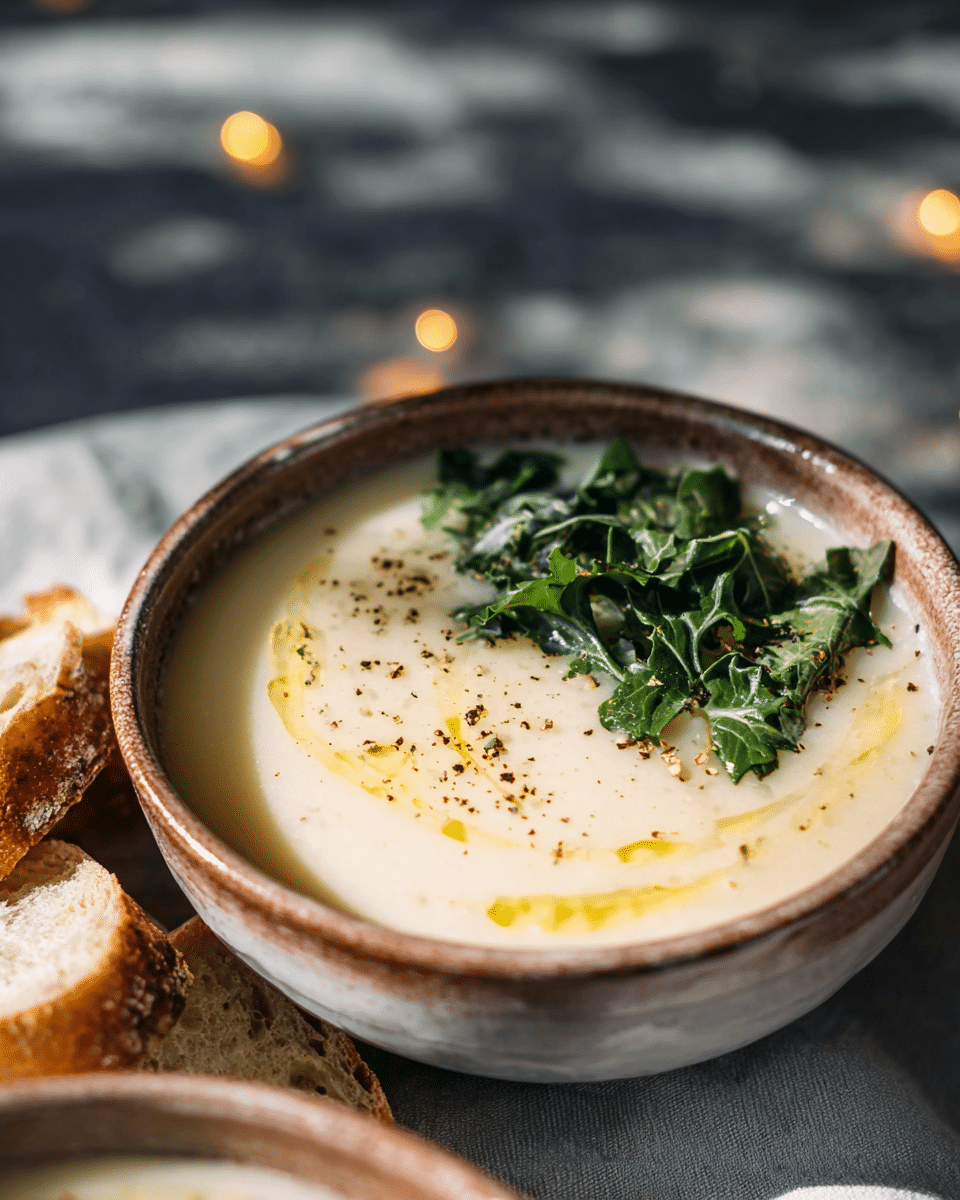This creamy kohlrabi soup is a comforting yet light dish perfect for any season. With its subtle sweetness and earthy flavor, kohlrabi shines in this dairy-free recipe that gets its silkiness from blended vegetables and a touch of coconut milk. It’s a warm, nourishing bowl that’s both vegan and gluten-free—ideal for cozy lunches or elegant starters.
FULL RECIPE
Ingredients
- 2 tablespoons olive oil
- 1 medium onion, chopped
- 2 garlic cloves, minced
- 1 celery stalk, chopped
- 3 cups peeled and cubed kohlrabi (about 2 medium bulbs)
- 1 medium potato, peeled and diced
- 3 cups vegetable broth
- 1 cup unsweetened coconut milk (canned)
- ½ teaspoon dried thyme
- Salt and pepper, to taste
- Fresh chives or parsley, for garnish (optional)
Directions
- Heat olive oil in a large pot over medium heat. Add the onion and sauté for 3–4 minutes until softened.
- Stir in garlic and celery, cooking for another 2 minutes until fragrant.
- Add kohlrabi and potato. Cook for 5 minutes, stirring occasionally.
- Pour in the vegetable broth and bring to a boil. Reduce heat, cover, and simmer for 20 minutes or until vegetables are very tender.
- Remove the pot from heat. Use an immersion blender to puree the soup until smooth, or carefully transfer to a blender in batches.
- Return the soup to low heat. Stir in coconut milk and thyme. Simmer for 5 more minutes, then season with salt and pepper to taste.
- Ladle into bowls and garnish with fresh herbs, if desired. Serve hot.
Nutrition Facts
- Calories: 180
- Total Fat: 10g
- Saturated Fat: 4g
- Cholesterol: 0mg
- Sodium: 420mg
- Total Carbohydrates: 20g
- Dietary Fiber: 4g
- Sugars: 4g
- Protein: 3g
Nutritional Benefits of Kohlrabi Soup
Kohlrabi, the star ingredient of this creamy soup, is a nutritional powerhouse that contributes to the overall health benefits of the dish. Low in calories but rich in vitamins such as vitamin C and B-complex, it supports immune function and energy metabolism. The soup’s inclusion of coconut milk adds healthy fats that improve nutrient absorption, while the vegetable broth provides minerals like potassium. Combined, these ingredients offer a well-balanced meal that supports digestion, boosts immunity, and promotes heart health. The soup is also high in dietary fiber, aiding in satiety and blood sugar regulation.
Why Dairy-Free Matters
This recipe is completely dairy-free, making it accessible to those with lactose intolerance, dairy allergies, or those following a vegan lifestyle. Traditional creamy soups often rely on heavy cream or milk, which can be problematic for many. Using coconut milk instead provides a creamy texture without the dairy, while also adding subtle tropical notes. This alternative supports better digestion for sensitive individuals and keeps the recipe light and suitable for a variety of dietary needs.
The Versatility of Kohlrabi
Kohlrabi is a versatile vegetable that can be enjoyed raw, roasted, or blended into soups like this one. Its mild, slightly sweet flavor allows it to take on various seasonings and preparations easily. In this soup, kohlrabi’s natural creaminess when cooked and blended provides a perfect base. Beyond soup, it can be shredded into salads, sautéed as a side dish, or even spiralized into noodles, offering a low-carb alternative to pasta.
Flavor Profile and Seasoning Tips
The flavor of this creamy kohlrabi soup is delicate and earthy, enhanced by the sweetness of the vegetable and the richness of coconut milk. The addition of thyme adds a herby depth, but other herbs like rosemary or dill could also complement the soup well. For a bit of warmth, a pinch of smoked paprika or cayenne pepper can be introduced. Seasoning with salt and pepper is key to balancing the natural flavors, and garnishing with fresh herbs like chives or parsley brings brightness and freshness.
Variations to Customize Your Soup
This recipe is highly adaptable to suit different tastes and dietary preferences. For added protein, consider stirring in cooked lentils or white beans. For a spicier twist, add diced jalapeños or a dash of chili flakes. If you prefer a nuttier flavor, swapping coconut milk for almond or cashew cream works beautifully. Adding root vegetables such as carrots or parsnips can increase sweetness and complexity. Each variation allows for creativity while maintaining the soup’s creamy, comforting essence.
Perfect Pairings for Serving
Creamy kohlrabi soup pairs wonderfully with a variety of sides that enhance its cozy qualities. Crusty artisan bread or garlic toast are classic accompaniments for dipping and soaking up the soup’s flavors. For a lighter option, a fresh green salad with a tangy vinaigrette provides a refreshing contrast. Roasted vegetables or a simple grain bowl with quinoa or wild rice can round out the meal for a more substantial dinner. These pairings help balance textures and flavors on the plate.
Storage and Reheating Guidelines
Proper storage of this soup ensures you can enjoy leftovers safely and conveniently. Allow the soup to cool completely before transferring it to an airtight container. It will keep well in the refrigerator for up to 4 days. For longer storage, freezing in portions is ideal—use freezer-safe containers or bags and consume within 2 months for optimal flavor. When reheating, warm gently on the stove or in the microwave, stirring occasionally to maintain the creamy texture. If the soup thickens too much, adding a splash of broth or coconut milk can help restore consistency.
Health Considerations and Dietary Compatibility
This soup fits well into a variety of diets including vegan, gluten-free, and paleo-friendly regimens. Its whole-food ingredients make it a great option for those aiming to eat clean and avoid processed additives. The fiber content supports digestive health, while the absence of dairy and gluten reduces the risk of common allergens. Additionally, the moderate fat content from coconut milk provides sustained energy without heaviness, making it suitable for both light meals and post-workout nourishment.
Seasonal Adaptability and Ingredient Substitutions
While kohlrabi is available year-round in many places, this soup shines in cooler months when warm, comforting dishes are most welcome. However, if kohlrabi isn’t available, you can substitute with other mild-flavored root vegetables like turnips or rutabaga for a similar texture and flavor profile. Coconut milk can be replaced with other plant-based milks like oat or cashew milk if desired, though this may slightly alter the creaminess and flavor. Flexibility in ingredients allows you to enjoy this soup anytime, regardless of seasonal availability.
Cultural and Culinary Context of Kohlrabi Soup
Kohlrabi is widely used in Central European and Indian cuisines, often prepared in stews, salads, or soups. This creamy version highlights modern adaptations that cater to contemporary dietary needs and global palates. The dairy-free aspect nods to traditional coconut-based dishes found in Southeast Asia, blending culinary traditions into a harmonious dish. This soup is a perfect example of how humble vegetables can be elevated into elegant comfort food enjoyed across cultures.
Conclusion
Creamy kohlrabi soup offers a perfect blend of nourishment, comfort, and culinary versatility. Its dairy-free nature opens it up to many dietary lifestyles while the gentle flavors appeal to a wide audience. Whether served as a light lunch, a starter for dinner, or prepared in advance for busy days, this soup provides warmth and wellness in every spoonful. With its simple ingredients and adaptable recipe, it invites home cooks to experiment and make it their own, celebrating the humble kohlrabi in a deliciously creamy form.






